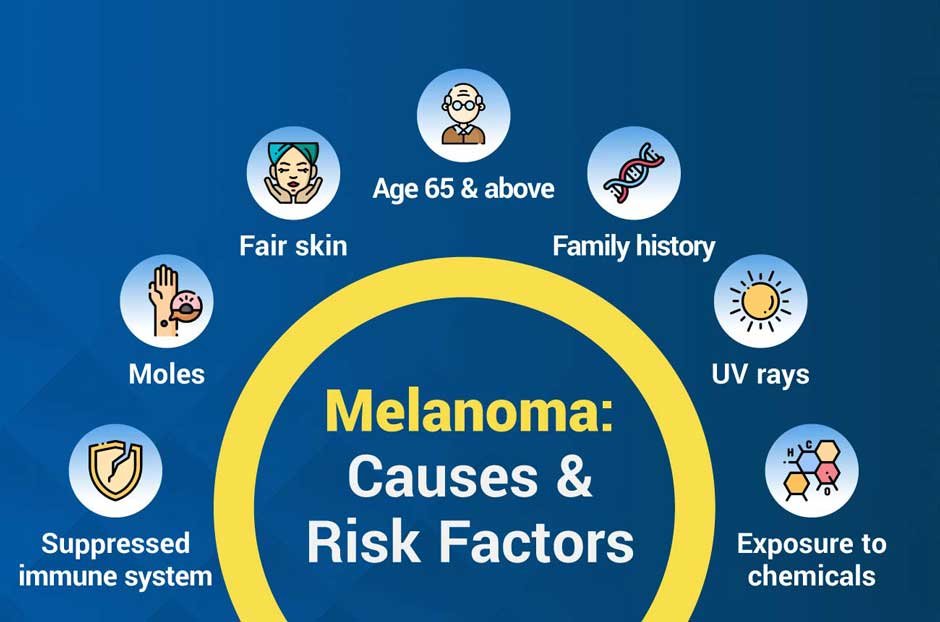Melanoma is a type of skin cancer that develops in cells called melanocytes that produce pigment or melanin in the skin. It can occur anywhere on the skin, but it is most found on the upper back, legs, arms, and face. Melanoma can vary in color and appearance, but it typically appears as a new or changing mole. It can be black, brown, or in other colors, and it can be raised or flat.
Causes and Risk Factors of Melanoma Skin Cancer

The exact cause of skin cancer like melanoma is not known, but several factors have been linked to its development.
Fair skin
People with fair skin, blond or red hair, and blue or green eyes are at a higher risk of developing melanoma skin cancer. It is because fair skin has less melanin, the pigment that provides some protection from the sun’s UV rays.
Moles
People with many moles, or moles that are large or irregular in shape, are at a higher risk of developing melanoma. Additionally, people with atypical moles (also known as dysplastic nevi) have an increased risk of developing melanoma.
Age
Melanoma can occur at any age, but it is more common in older adults. The risk of developing melanoma increases as a person gets older.
Family history
People with a family history of melanoma are at a higher risk of developing the disease. If a person’s first-degree relative (such as a parent or sibling) has had melanoma, their risk of developing the disease is 2-3 times higher than in the general population.
Overexposure to UV rays
One of the main risk factors for melanoma is overexposure to ultraviolet (UV) rays from the sun or from tanning beds. UV rays can damage the DNA in skin cells, which can lead to the development of melanoma.
Suppressed immune system
People with a weakened immune system, such as those with HIV/AIDS or those receiving immunosuppressive therapy, have a higher risk of developing melanoma. This is because a healthy immune system can detect and destroy abnormal cells before they can develop into cancer.
Exposure to certain chemicals
Some chemicals, such as tar, soot, and certain types of industrial oils, have been linked to an increased risk of developing melanoma. Additionally, people who have been exposed to radiation or have had certain types of skin diseases or infections may also have a higher risk of developing melanoma.
How to Prevent Melanoma Skin Cancer

1. Limit exposure to sunlight
UV radiation can cause mutations in the DNA of melanocytes, which can lead to the uncontrolled growth of cancerous cells. Limit the amount of time spent in direct sunlight, especially during the hours of peak UV radiation, generally between 10 am and 4 pm. When spending time outdoors, apply sunscreen, seek shade, and wear protective clothing.
2. Stay out of tanning beds
Tanning beds emit UV rays that can increase the risk of developing melanoma. The World Health Organization has classified tanning beds as a Class 1 carcinogen, which means they are known to cause cancer. UV radiation from tanning beds is like UV radiation from the sun and can cause damage to the DNA in skin cells, which can then lead to the development of cancer.
3. Wear sunscreen
Sunscreen is considered one of the most effective ways to protect your skin from UV rays and decrease your risk of melanoma. It works by absorbing or reflecting UV rays before they can penetrate the skin.
Always use sunscreen with a sun protection factor (SPF) of at least 30 when stepping out, even in the cloudy days. Apply it generously to all exposed areas of the skin, including the face, ears, neck, and hands. Make sure to reapply sunscreen every 2 hours or after swimming or sweating.
4. Avoid tanning lotions and sprays
Tanning lotions and sprays contain dihydroxyacetone (DHA), a colorless sugar that causes a browning reaction on the skin. DHA interacts with amino acids and dead skin cells on the surface of the skin to darken it, giving the appearance of a tan.
However, DHA does not protect the skin from UV radiation, and using these products can increase the risk of skin damage and skin cancer, including melanoma. Additionally, tanning lotions and sprays are not regulated by the FDA. Therefore, they may contain harmful ingredients that can damage the skin.
5. Do not miss regular check-ups
Melanoma is a type of skin cancer that can spread to other parts of the body if not caught early. By regularly checking your skin for changes in the size, shape, color, or texture of moles or other skin growths, detecting any abnormalities early becomes easy.
Healthcare providers can also do a full-body skin examination to check for any suspicious moles or other growths. If a person notices any changes, they should consult a dermatologist to have their skin checked.
Survival Rate for Melanoma Cancer
The American Cancer Society estimates that around 91% of melanoma cases are diagnosed at an early stage when it is still localized and has not spread to other parts of the body. In these cases, the 5-year survival rate is around 99%. However, if melanoma is not caught until it has spread to other parts of the body, the 5-year survival rate drops to around 14%. For quality cancer care for melanoma skin cancer, contact ACTC, one of the best cancer treatment centers in Florida.
Conclusion
Melanoma is a serious form of skin cancer that can be life-threatening if not caught early. However, these preventative steps can go a long way in reducing the risk of developing this disease. It is also important to be aware of the risk factors and get checked at regular intervals. Consult a dermatologist at the earliest if any suspicious changes are noticed.

